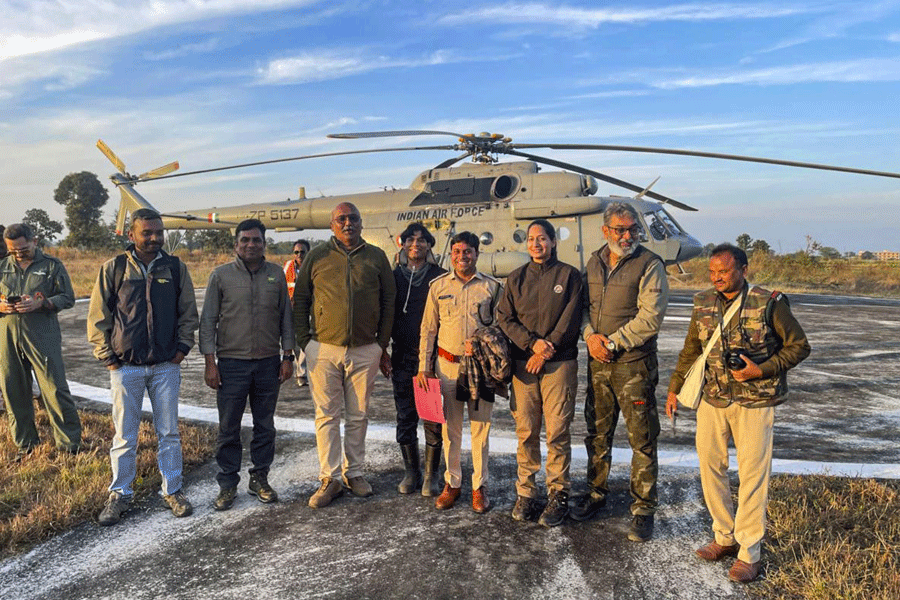“The fabled musk deer searches the world over for source of the scent, which comes from itself”— Ramakrishna Parmahansa.
In fact, it is not the deer alone that is enticed by its own smell. The deer and its fabled musk have been enticing men and women, and somtimes even gods, since time immemorial. It was the “lure” of a mrig (deer) that sent Rama chase it, leaving Sita alone in the jungle during their exile. And exploiting the situation, the demon king Ravana abducted her to Lanka.
But the loss of a spouse by the legendary king of Ayodhya failed to deter us from loving this animal for its grace, speed and beautiful doe-eyes. Perhaps, it was this love that led the government to set up the Birsa Mrig Vihar, popularly known as “Deer Park” at Kalamati in Khunti, about 25 km from the capital on the Ranchi-Khunti Road, in 1987, to breed and eventually augment their number in the wild by releasing them in the sanctuaries and forests.
“Our efforts have paid off. The park at Kalamati has 234 deer at present and their number is steadily growing. We have decided to release 30 to 35 deer in different sanctuaries and forests from this year. It’s for the first time that we would be releasing deer in their natural habitat,” said principal chief conservator of forests (PCCF) A.K. Singh.
The population spurt in the park appears to be a sort of a “compensation” for the heavy loss of life at the Birsa Munda Biological Park at Orjmajhi, where five tigers recently died due to a disease referred to as “babesiosis”. Even experts from Bhubaneshwar and Calcutta, who turned up, failed to save them despite best efforts.
“It is for everyone to see how healthy our deer are,” said caretaker Bimlesh Kumar Pandey pointing towards a herd running and frolicking around a pond in the park.
A visit to the park and spending some time there proved beyond all doubts that the deer are relatively well-fed and are taken care of. Spread over 55 acres of land dotted with tall saal and plenty of shrubbery creating natural hideouts, the park offers enough space for the animals to run round.
Besides, the park has four large ponds where the graceful creatures may seek relief from the scorching summer’s heat. Apart than these, there are five water tubs for the deer. When it comes to food there is plenty. “We get sufficient grains to feed all. There is 250 kg of wheat, maize and dalia, 25 kg of lentils, besides other fodder to feed the animals every day,” informed Pandey.
The experts, however, say the deer are browsers rather than grazers and feed on a variety of vegetation, including green plants, nuts and corn, and trees and twigs.
The park is a green paradise, with lush foliage, particularly during the rains. Although, the deer are great swimmers and fast runners (sometimes touching 35 mph), it falls prey to a number of animals, including cougar, domestic dog, wolf, coyote, lynx, bobcat and bear. So, the wild life conservation wing of the state’s forest department has made check posts at all the four entry points of the park, with guards standing round the clock to stop any predators from entering the park.
“We started the park with only 30 animals in 1987. Now the number has risen to 234. There are two types of deer in the park; the Cheetal and the Sambhar. There are 179 Cheetals and 55 Sambhars,” said one caretaker.
The PCCF, however, added that according to the stipulated capacity of the park, it shouldn’t house more than 200. “That’s why we have decided to release 34 to 35 animals in the jungles and the sanctuaries.”
Much like other bigger mammals, a doe has a long gestation period of 11 months and usually give birth to a single foal in a year. But proper care and upkeep has ensured that the park, which is a one-of-its-kind in Jharkhand, Bihar, Orissa and Bengal, not only achieves its aim but helps other parks, forests and sancturies in deer conservation. Thanks to it, wild deer in Saranda and other forests, would soon find an increase in the number of their friends.
The divisional forest officer (DFO), Dinesh Kumar, says: “The Birsa Mrig Vihar has been set up with an aim to educate and create awareness among the people about the lovely creatures, besides breeding them.”
The park has quite a good number of guides to take the clueless traveller around. They also seem knowleged about the animal and park details. The park attracts quite a heavy rush of tourists and visitors every day, particularly in the ongoing holy month of Sawaan and also during January-February.
Then the journey to the park promises more. The famous Shiv temple at Angrabadi is only 20 km from the park and falls on the same road. The temple attracts a large number of devotees during the ongoing month. Most, make it a point to visit the park.
A wildlife lover can easily spend hours and days in the park to watch the greyish-brown, shy and tremulous creatures. Ironically, the male of the species are timid and coy, despite the fact that they have long branched-out antlers. Though they move in packs, they have a tendency to flee whenever they see humans.
Ironic, considering that humans have loved watching and befriending them since time immemorial.










